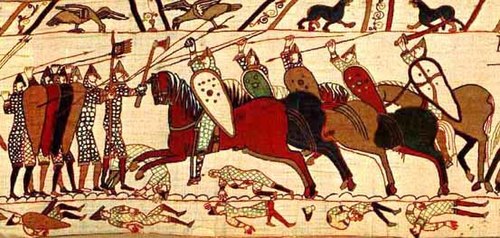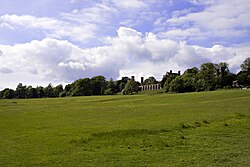Battle of Hastings
The Battle of Hastings (14 October 1066) was a pitched battle between the Anglo-Saxon English and an invading Norman army.[a][2] It lasted a day and ended in the death of the Anglo-Saxon king, Harold Godwinson, and a decisive victory for the Normans.
| Battle of Hastings | |||||||
|---|---|---|---|---|---|---|---|
 A picture of the Battle of Hastings from the Bayeux Tapestry | |||||||
| |||||||
| Belligerents | |||||||
| Kingdom of England | Normans | ||||||
| Commanders and leaders | |||||||
| Harold Godwinson † | William the Conqueror | ||||||
William, the Duke of Normandy, was crowned as King William I of England ten weeks later. The Norman conquest was a major turning point in English history.[3]
Background
In 1002 Ethelred, the King of England, married Emma, the sister of Richard II, Duke of Normandy.[4] The alliance formed by the marriage had far-reaching effects.[4] When King Canute came to the throne of England in 1016, he took Queen Emma of Normandy as his wife. Her two sons by her former marriage fled to Normandy for their own safety.
Edward the Confessor, the older son, stayed in Normandy for many years at the court of the dukes. The last duke who protected him there was his cousin Duke William. Edward became King of England in 1042. Edward, who was childless, made William his heir in 1052.[5] Harold Godwinson was in Normandy in 1065 and promised Duke William that he would support William as successor to the English throne.[6]
On 5 January 1066, Edward died, but Harold did not respect his oaths to William.[7] The next day, the funeral occurred, amd Harold was crowned King of England.[6] The story was that on his deathbed the king had changed his mind and promised Harold the throne. Harold was not royalty himself and had no legal claim on the throne.[7] For weeks, William must have known Edward was dying,[8] but the news of the king's death and of Harold's taking the throne must have been a surprise.[8]
When William heard the news that Harold had become king, his reaction was swift. He called a meeting of his greatest men[9] and made plans to gather a large army from all over France.[10] His influence and wealth meant that he could mount a large campaign.[10] His first task was to build a fleet of ships to carry his army across the English Channel.[10] Then, he started gathering an army. His friendship with Brittany, France and Flanders meant that he did not have to rely only on his own army.[10] He hired and paid soldiers from many parts of Europe. William asked for and got the support of the pope, who gave him a banner to carry into battle.[11] While Duke William was planning his invasion, Harald Hardrada of Norway was planning another. Harold knew that both would be coming but kept his ships and forces in southern England, where William might land.[12]
William may have had as many as 1,000 ships in his invasion fleet.[13] They had favourable winds to leave Normandy on the night of 27 September 1066.[14] William's ship, the Mora, was a gift of his wife, Matilda,[13] and led the fleet to the landing at Pevensey the next morning.[14] As soon as he landed, William got news of Harold's victory over the Norwegian king at Stamford Bridge, in northen England.[15] Harold also received news that William had landed at Pevensey and went south as quickly as he could. Harold rested at London for a few days before he took his army to meet William and his French forces.[15]
Battle

Harold's army took up a position on an east-west ridge north of Hastings.[16] called Senlac Hill.[17] It found the Norman army marching up the valley in front. Harold had more soldiers, but they were tired from the forced march from London.[16] William formed his lines at the base of the hill facing the Englsh shield wall[b] and sent his archers halfway up the slope to attack the English.[16] He sent his mounted knights to the left and right to find any weak spots.[16]
At first, William's knights tried to break through the shield wall by the weight of their horses.[19] However, they were attacking uphill and could not gain any speed. Harold's front line simply stood fast and fended off any attacks.[19] William's army began to fall back because of rumours of his death. William removed his helmet to let his men see that he was still alive.[19] When William saw that many of Harold's men followed his knights back down the hill, he used a trick that he had learned years before. He turned suddenly and charged the oncoming English foot soldiers, who had no chance against mounted knights.[19]The tactic worked at least two more times during the battle and made Harold's shield wall weaker.[20]
Next, William used something new. His attacks by knights and soldiers had been separate movements, but he now used them together.[20] His archers had not succeeded against the shield wall, but he now had them shoot high into the air so that the arrows came down on top of the English.[20] Harold was then killed, perhaps by an arrow through his eye at the time.[20] The shield wall finally broke, and the Normans were on top of them. By nightfall, the English were dead on the field or being hunted down by William's men.[20] William called his men back, and they spent the night camped on the battle field. [20]
Aftermath
The battle was won, but the English still had smaller armies that had not joined King Harold at Hastings.[21] They had lost their king but were still trying to reorganise. William rested his army for five days before he moved toward London.[21] His line of march took him through several towns, which he captured or destroyed.[21] When William reached London, the English briefly resisted but in the end surrendered.[21]
The Battle of Hastings was a major turning point in English history. William's claim to the throne was strong, and he had backed it up with force. On Christmas Day in 1066, William was crowned King of England.[22]
Sometime later, the battle was pictured on a series of panels called the Bayeux Tapestry.[23] William's victory at Hastings gave him the nickname by which he has been known ever since: 'William the Conqueror'.[24]
Battle Of Hastings Media
The location of the Battle of Stamford Bridge
Norman knights and archers at the Battle of Hastings, as depicted in the Bayeux Tapestry
View of the battlefield looking towards Senlac Hill
Stone marking the spot of the high altar at Battle Abbey, where Harold died
Notes
- ↑ William had avoided pitched battles in his career as a Duke. His preferred style was typical of the time, with quick surprise attacks and sieges or defences of castles and strong points.[1]
- ↑ A shield wall is a "wall of shields" formed by soldiers who stand in line very close to one another. They interlocked their shields to form a barrier so that the enemy cannot easily get through.[18]
References
- ↑ Edward Augustus Freeman, William the Conqueror (New York; Perkins Book Co., 1902), p. 59
- ↑ "battle of Hastings". Vocabulary.com. Retrieved 11 April 2016.
- ↑ Iggulden, Hal; Iggulden, Conn (2007). "Famous Battles – Part One: 4. Hastings October 14, 1066". The Dangerous Book for Boys. New York: HarperCollins. pp. 57–58. ISBN 978-0061243585.
- ↑ 4.0 4.1 David C. Douglas, William the Conqueror; The Norman Impact upon England (Berkeley; Los Angeles, University of California Press, 1964), p. 160
- ↑ David C. Douglas, William the Conqueror: the Norman impact upon England (Berkeley; Los Angeles, University of California Press, 1964), p. 169
- ↑ 6.0 6.1 The Normans in Europe, trans. & ed. Elisabeth van Houts (Manchester, UK: Manchester University Press, 2000), p. 104
- ↑ 7.0 7.1 François Neveux, The Normans; The Conquests that Changed the Face of Europe, trans. Howard Curtis (London: Constable & Robinson Ltd., 2008), p. 130
- ↑ 8.0 8.1 David C. Douglas, William the Conqueror; The Norman Impact upon England (Berkeley; Los Angeles, University of California Press, 1964), p. 181
- ↑ David C. Douglas, William the Conqueror; The Norman Impact upon England (Berkeley; Los Angeles, University of California Press, 1964), p. 184
- ↑ 10.0 10.1 10.2 10.3 François Neveux, The Normans; The Conquests that Changed the Face of Europe, trans. Howard Curtis (London: Constable & Robinson Ltd., 2008), p. 132
- ↑ John Malam, The Battle of Hastings (Slough: Cherrytree, 2007), p. 15
- ↑ David C. Douglas, William the Conqueror; The Norman Impact upon England (Berkeley; Los Angeles, University of California Press, 1964), p. 191
- ↑ 13.0 13.1 Elisabeth M.C. van Houts, 'The Ship List of William the Conqueror', Anglo-Norman Studies X, ed. R. Allen Brown (Woodbridge, The Boydell Press, 1988), p. 166
- ↑ 14.0 14.1 David C. Douglas, William the Conqueror; The Norman Impact upon England (Berkeley; Los Angeles, University of California Press, 1964), p. 396
- ↑ 15.0 15.1 David Crouch, The Normans; The History of a Dynasty (London; New York: Hambledon Continuum, 2007), p. 89
- ↑ 16.0 16.1 16.2 16.3 David Crouch, The Normans; The History of a Dynasty (London; New York: Hambledon Continuum, 2007), p. 92
- ↑ Fiona Reynoldson; Clive Griffiths; et al., Life in Medieval Times (Oxford: Heinemann Educational, 2002), p. 30
- ↑ David Nicolle; Adam Hook, European Medieval Tactics: The Fall and Rise of Cavalry, 450-1260 (Oxford: Osprey, 2011), p. 21
- ↑ 19.0 19.1 19.2 19.3 David Crouch, The Normans; The History of a Dynasty (London; New York: Hambledon Continuum, 2007), p. 93
- ↑ 20.0 20.1 20.2 20.3 20.4 20.5 David C. Douglas, William the Conqueror; The Norman Impact upon England (Berkeley; Los Angeles, University of California Press, 1964), p. 201
- ↑ 21.0 21.1 21.2 21.3 Frank Stenton, Anglo-Saxon England, Third Edition (Oxford; New York: Oxford University Press, 1971), p. 596
- ↑ François Neveux, The Normans; The Conquests that Changed the Face of Europe, trans. Howard Curtis (London: Constable & Robinson Ltd., 2008), p. 138
- ↑ Lucien Musset, The Bayeux Tapestry (Woodbridge: Boydell Press, 2005), p. 14
- ↑ William W Lace, The Battle of Hastings (San Diego: Lucent Books, 1996), p. 28








